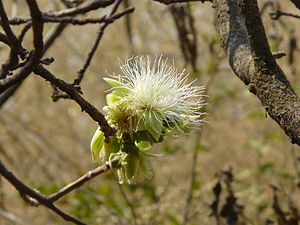Note: This is a project under development. The articles on this wiki are just being initiated and broadly incomplete. You can Help creating new pages.
Difference between revisions of "Careya arborea - Kubhīkaḥ"
(→List of Ayurvedic medicine in which the herb is used) |
(→References) |
||
| Line 74: | Line 74: | ||
<ref name="Leaf">[ "Morphology"]</ref> | <ref name="Leaf">[ "Morphology"]</ref> | ||
<ref name="Cultivation details">[https://shodhganga.inflibnet.ac.in/bitstream/10603/3893/10/10_chapter%204.pdf"Cultivation details"]</ref> | <ref name="Cultivation details">[https://shodhganga.inflibnet.ac.in/bitstream/10603/3893/10/10_chapter%204.pdf"Cultivation details"]</ref> | ||
| + | <ref name="Ayurvedic preparations">[https://easyayurveda.com/2017/10/05/kumbhi-tree-careya-abrorea-ceylon-oak/"Ayurvedic preparations"]</ref> | ||
</references> | </references> | ||
Revision as of 14:57, 4 June 2019
Kulaµjana consists of dried rhizome of Alpinia galanga Willd. (Fam. Zingiberaceae), a plant upto about 2.0 m high bearing perennial rhizome, growing in eastern Himalayas and southwest India.
Contents
- 1 Uses
- 2 Parts Used
- 3 Chemical Composition
- 4 Common names
- 5 Properties
- 6 Habit
- 7 Identification
- 8 List of Ayurvedic medicine in which the herb is used
- 9 Where to get the saplings
- 10 Mode of Propagation
- 11 How to plant/cultivate
- 12 Commonly seen growing in areas
- 13 Photo Gallery
- 14 References
- 15 External Links
Uses
Parts Used
Chemical Composition
Saponins (five sapogenols- careyagenol A, B, C, D & E); sterols, α-spinosterol and α-spinosterone[1]
Common names
| Language | Common name |
|---|---|
| Kannada | Daddala, Gudda, Daddippe |
| Hindi | |
| Malayalam | Pezuntol |
| Tamil | Kumbi |
| Telugu | Dudippi |
| Marathi | NA |
| Gujarathi | NA |
| Punjabi | NA |
| Kashmiri | NA |
| Sanskrit | Svādupuṣpa, Viṭapī, Sthala Kumbhī |
| English | Kumbi |
Properties
Reference: Dravya - Substance, Rasa - Taste, Guna - Qualities, Veerya - Potency, Vipaka - Post-digesion effect, Karma - Pharmacological activity, Prabhava - Therepeutics.
Dravya
Rasa
Kaṭu, Kaṣāya
Guna
Rūkṣa
Veerya
Uṣṇa
Vipaka
Kaṭu
Karma
Kaphahara, Vātahara, Grāhī,
Prabhava
Habit
Identification
Leaf
| Kind | Shape | Feature |
|---|---|---|
| Paripinnate | Oblong | Leaf Arrangementis Alternate-spiral |
Flower
| Type | Size | Color and composition | Stamen | More information |
|---|---|---|---|---|
| Unisexual | 2-4cm long | pink | Flowering throughout the year and In terminal and/or axillary pseudoracemes |
Fruit
| Type | Size | Mass | Appearance | Seeds | More information |
|---|---|---|---|---|---|
| oblong pod | Thinly septate, pilose, wrinkled | seeds upto 5 | Fruiting throughout the year |
Other features
List of Ayurvedic medicine in which the herb is used
Where to get the saplings
Mode of Propagation
How to plant/cultivate
Fresh seeds germinate readily. Prefers a well-drained, sandy or even rocky soil. [4]
Commonly seen growing in areas
Primary or secondary forest, Slightly seasonal forest, Along forest edges.
Photo Gallery
References
- ↑ The Ayuredic Pharmacopoeia of India Part-1, Volume-5, Page no-14
- ↑ [ "Morphology"]
- ↑ "Ayurvedic preparations"
- ↑ "Cultivation details"
External Links
- Ayurvedic Herbs known to be helpful to treat Body swellings
- Ayurvedic Herbs known to be helpful to treat Cough
- Ayurvedic Herbs known to be helpful to treat Cold
- Herbs with Fruits used in medicine
- Herbs with Seeds used in medicine
- Herbs with common name in Kannada
- Herbs with common name in Malayalam
- Herbs with common name in Tamil
- Herbs with common name in Telugu
- Herbs with common name in Sanskrit
- Herbs with common name in English
- Habit - Deciduous tree
- Index of Plants which can be propagated by Seeds
- Herbs that are commonly seen in the region of Primary or secondary forest
- Herbs that are commonly seen in the region of Slightly seasonal forest
- Herbs that are commonly seen in the region of Along forest edges
- Herbs
- Ayurvedic herbs that don't have seed photos
- Lecythidaceae






